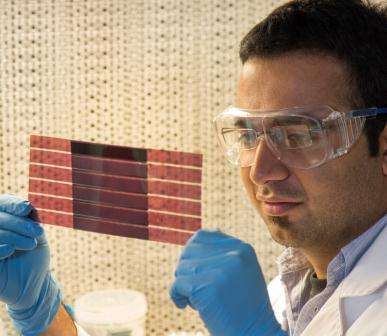Plastic solar cells pave way for clean energy industry

(Phys.org)—A Flinders University researcher has been developing a cheaper and faster way of making large-scale plastic solar cells using a lamination technique, paving the way for a lucrative new clean energy industry.
The novel method, developed by PhD candidate Anirudh Sharma, is a promising alternative to the expensive fabrication techniques currently used in the renewable energy sector, and would make the commercialisation of plastic solar cell technology more viable.
While plastic solar cells have been researched for the past 15 years, Mr Sharma said the current fabrication process, which involves vacuum conditions, was still relatively expensive and time-intensive for large-scale production compared to his lamination technique.
"In the conventional method of fabricating plastic solar cells you have to deposit various materials sequentially on top of each other in a sandwich structure but over time the materials intermix, leading to device degradation," Mr Sharma, based in the School of Chemical and Physical Sciences, said.
"However my technique involves deposition of materials on two different electrically conductive surfaces, followed by lamination. It gives better control over the material intermixing and thus can give more stable and better performing devices," he said.
"The entire lamination process is roll-to-roll compatible, which means that the lamination technique could be integrated with printing machines similar to newspaper printers.
Therefore the materials can be deposited by printing and devices can be fabricated by lamination at the same time, making the entire process scalable at relatively much lower costs.
"This is a much cheaper way of fabricating solar cells because you can make a large number of devices in a very short time, and this method of self-encapsulation can potentially help improve the life-span of the device as well."
Mr Sharma said plastic solar cells were a cheaper and more sustainable form of renewable energy compared with silicon-based devices.
"For the past 50 years, the traditional solar panels which you see on rooftops have been made from silicon but these cells are very expensive to produce because silicon requires excessive amounts of energy to purify.
"Plastic solar cells, on the other hand, are really light and flexible so they can be used to coat a whole range of different surfaces – they are portable enough to put them on day to day carry bags and even camping tents – and plastic itself is cheap as chips.
"Building developers are already looking at integrating plastic solar cells with the latest building designs by using plastic solar cell-coated window panes for new buildings so this technology will definitely replace silicon in the very near future.
"And my research shows real promise for a faster, more cost-effective way of making plastic cells."
Provided by Flinders University


















